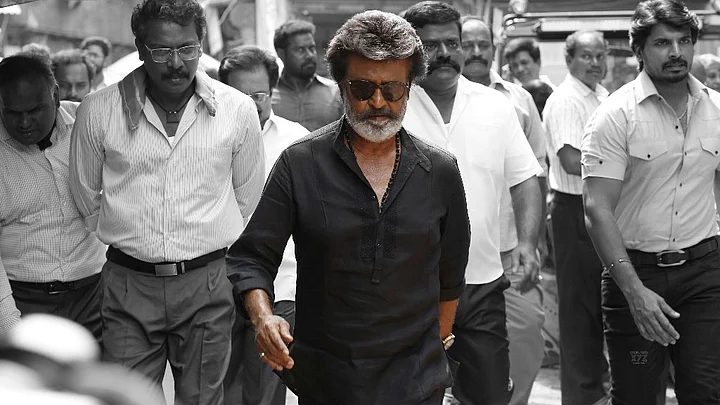In his classic work The Fire Next Time, James Baldwin wrote the following lines of advice to his fellow black Americans:
“The details and symbols of your life have been deliberately constructed to make you believe what white people say about you. Please try to remember that what they believe, as well as what they do and cause you to endure, does not testify to your inferiority but to their inhumanity and fear.”
If there is one Indian director who has understood fully this power that symbols wield and then used it to immense effect, it is undoubtedly Pa. Ranjith. His latest film Kaala, from its very title onwards, is testament to his skill at doing this. Dharavi as a space has been so overexposed to misuse and abuse in the name of art (and political art), that it seems no easy task to pull off the kind of film that he has.
And yet he has. His nuanced understanding of the visceral realities of caste echoes the deep pangs of lived experience.
Kaala uses land as an entry point to begin its political journey. From the very outset, it is clear in asserting that power lies in the material and not the abstract – that the roadblocks, friction and violence that communities experience are almost always the flip side of a coin that talks about cleanliness, purity and development.
It confirms people’s humanity by reminding us, like Baldwin, that poverty and stigma are not natural – but that they are created and regularly, violently sustained.
In this backdrop, Ranjith’s approach to symbols becomes all the more relevant. In most Indian films that deal with “caste realities” – the method is often only through victimhood and atrocities. This then gets reflected in society as well – when the only time and context in which people like to bring up caste is in the context of reservations and the search for a “real” or “perfect” kind of victimhood. Ranjith overturns this in his films by bringing us to caste through a bold and shining hero’s victorious struggle.
Ranjith diagnoses the point that caste hierarchies are both based on and yet transcend class structures. When discussing the problems of Dharavi – his characters obviously talk of space, services and infrastructure – but also recognize the deep violence in the way ‘Dharavi’ as a word itself is used pejoratively or in a negative context. The struggle is not simply economic – it is an assertion of a dignity that runs deeper; to insist there is pride in the identity markers that are the cause of one’s exclusion. A large part of our urban violence – particularly evictions – is because of perception, and the hatred in the gaze with which decision makers and civil society actors look upon people as ‘unclean’.
Kaala delves into lives and cultures, and shows us that contrary to the perception of ‘unclean’ – if at all there is anything ‘clean’ about the Indian city, it is thanks to them. The film, in the spirit of Baldwin, repeats that the way people treat you is testament to their own fear and inhumanity, and not your own inferiority.
There can be no doubt about the radical victory in bombarding an audience that came to watch mindless Rajinikanth entertainment with audacious and intrepid dialogues about the politics of Ambedkar’s suit or why black is the colour of the proletariat.
It is likely that many pieces will come out over the next few days that will try to capture all the anti-caste symbols that Ranjith throws into the film – from Buddha to Phule and Ambedkar to Periyar, from his colour contrasts of black, red and blue against a hallowed-but-shallow ‘white’ purity to his not-so-veiled attacks on religiously polarizing ideologues and charlatans. There can be no question that these choices are meant to be clearly and visibly political.
But perhaps the question that filmmakers like Ranjith ought to provoke in us is why we see the ‘political’ only in the explicit, and why we are almost never able to pick up on the deep symbolisms that have now just come to represent ‘normal’.
It's easy to see images and idols of the Buddha and Ambedkar as political, 'radical' symbols in any Pa. Ranjith film. It's much more difficult to extend that logic and consciously look at every karva chauth scene, puja room, rama-krishna idols, aarti thalis, janeus and so many other social and caste markers in the backdrops and subtexts of literally every other Indian film as an equal and opposite 'political' symbol - a symbol of who owns and controls the vast majority of all cinematic production in the country; of who gets to define what is “normal”.
Kaala’s great achievement is in reminding us that caste is not just limited to abstract discrimination – it is about region, about space, about property, about production, about politics, about life itself in this country. It exists and informs everything from the unwillingness to have a sip of water in certain homes to the business interests in evicting millions of people. It even informs the very calls to boycott the film Kaala as a punishment for Rajinikanth’s real-life politics – when the actual film is nothing but a blatant display of the ocean of difference between the actor and the director’s worldviews.
Kaala’s radical potential is that it’s a mainstream but deeply uncomfortable, polarizing conversation within society.
But is there any way to meaningfully chart a course forward in such a deeply stratified society without a few such uncomfortable conversations?
(Pranav Kuttaiah is a Research associate at the Centre for Policy Research, New Delhi.)
(The article is from The Quint's archives and has been republished on the occasion of Rajinikanth being conferred with the Dadasaheb Phalke Award)
